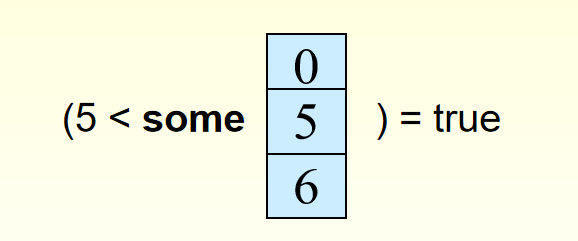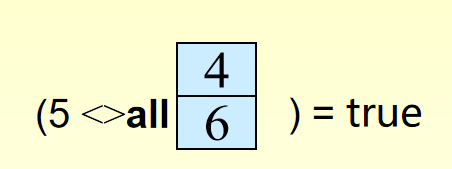1 SQL表内类型
char(n) 固定长度n的字符
varchar(n) 最大长度n的可变字符
比如我char(20) 的一个元素值为“vs”则占用20字节,如果varchar(20)的一个元素值为”vs”,则占用字节为2
int 整形
smallint 小整形
numeric(p,d ) 固定小数点位数,特定精度 如 numeric(3,1) 支持 44.5
float
double
2 SQL增删改语句
2.1 创建表 create
语法
注意不要丢掉分号
示例:
1 | create table department( |
指定主键
primary key(dept_name)
指定非空属性
dept_name varchar(20) not null
制定外键
foreign key (name) references instructor
2.2 删除表 drop
1 | drop table r; |
删除原本表
2.3 表中添加属性 alter… add
1 | alter table r add A D; |
为表添加A D属性
2.4 添加新的元组信息 insert…into…
1 | insert into instructors values("10211","Simith","Biology") |
2.5 删除表所有元组 delete from …
1 | delete from instructor |
删除元组,但表还在
2.6 更改元组 update
示例:给收入低于 70000 的教师加薪 5%
1 | update instructor |
3 查询语句
查询结构
select 属性
from 表
where 谓词条件
多个表的时候,需要加表名.属性区分
1 | select name, instructor.dept_name, building |
注意
1 SQL语句大小写不敏感 name=NAME
2 选择结果可能会包含重复的结果
使用distinct去除重复
1 | select distinct dept_name |
3 使用*查询全部
1 | select * from instructor; |
4 选择中可以包括运算表达式
1 | select ID, name, salary/12 as monthly_salary |
表示选择工资除以12后选择出来
5 where谓词
1 | select name |
4 重命名
4.1 为什么用
as
1 在相同的关系中比较元组
示例:查找 Comp.Sci 部门中薪水高于至少一名讲师的所有讲师的姓名。
1 | select distinct T.name |
2 将长的名字改短
1 | select T.name, S.course_id |
3 结果属性修改名称
1 | select T.name as instructor_name, S.course_id |
5 字符操作
5.1 寻找匹配
like
% 子字符串匹配
__ 匹配任何字符串
|| 运算符用于附加两个字符串
举例
1 | 'Intro%' matches any string beginning with “Intro”. |
注意
1 大小写敏感
2 转义字符区分%
Match the string “100%”
like ‘100 %‘
5.2 function
Trim用来 移除字符串后面的空格
6 生序降序
order关键字
desc 降序
asc升序
示例1:按字母顺序列出物理系的所有教师
1 | select name |
示例2:按薪水和姓名列出讲师
1 | select * |
between
1 | select name |
等价于
1 | select name |
7 联合操作
7.1 并集Union
可以直接自动消除重复,不像选择子句。
例子1 :查找 2017 年秋季或 2018 年春季开设的课程
1 | select course_id |
如果我们想要保留所有重复值
用union all
1 | select course_id |
7.2 交集 INTERSECT
1 | select course_id |
7.3 差集 EXCEPT
1 | select course_id |
7.4 对于空值补充
1 任何包含Null的表达式返回为Null
例:
1 | 5 + null returns null |
2 任何包含Null的比较返回的值是未知的
例
1 | 5 < null or null <> null or null = null returns unknown |
3 对于布尔运算
1 | and : (true and unknown) = unknown, |
空值,未知检测
示例:查找工资为空的所有教师。
1 | select name |
都是用is的,注意不能用=来替代is 在null的情况下
8 聚合函数
Average: avg
Minimum: min
Maximum: max
Total: sum
Count: count
示例:查找计算机科学系教师的平均工资
1 | select avg (salary) as avg_salary |
8.1 group by
group by是一个限定函数,意味着在这种情况下,限定在哪里的一个范围内进行比较寻找
比如下面的例子,要找到每一个部门的平均值
示例:查找每个部门讲师的平均工资
1 | select dept_name, avg (salary) as avg_salary |
8.2 having
having相当于要加一个限定条件
示例:查找平均工资大于42000的所有部门的名称和平均工资
having相当于就是给Group加一个条件,比如在这个范围内大于42000的
1 | select dept_name, avg (salary) as avg_salary |
9 Nested Subqueries 嵌套子查询
9.1 Set Membership
in 和not in
示例: 查找所有姓名为“莫扎特”或“爱因斯坦”的教师
1 | select distinct name |
示例:查找已参加 ID 为 10101 的教师教授的课程部分的(不同)学生总数
1 | select count (distinct ID) |
9.2 Set Comparison
SQL also allows < some, <= some, >= some, = some, and <> some
定义: y < some (X) : y小于X中任一元素,则结果为true
比较
some 只要一个满足即可

all 所有满足

9.3 exist or not exists
exists 它的作用是检查子查询是否返回结果。如果子查询返回至少一行数据(即至少存在一个满足条件的匹配项),那么”EXISTS”返回TRUE,否则返回FALSE。
示例: 查找学过生物系所有课程的学生(ID、姓名)。
1 | select S.ID, S.name |
9.4 with as
临时的关系,一会儿的查询用到
示例: 查找预算最高的所有部门
1 | with max_budget (value) as |
题目
答案在最后
1 This Query can be replaced by which one of the following?
1 | SELECT name, course_id |
a) Select name,course_id from teaches,instructor where instructor_id=course_id;
b) Select name, course_id from instructor natural join teaches;
c) Select name, course_id from instructor;
d) Select course_id from instructor join teaches;
2 In the SQL given above there is an error . Identify the error.
1 | SELECT * FROM employee WHERE dept_name="Comp Sci"; |
a) Dept_name
b) Employee
c) “Comp Sci”
d) From
Explanation: For any string operations single quoted(‘) must be used to enclose.
3 Which one of the following has to be added into the blank to select the dept_name which has Computer Science as its ending string?
a) %
b) _
c) ||
d) $
4 If we want to retain all duplicates, we must write ________ in place of union.
a) Union all
b) Union some
c) Intersect all
d) Intersect some
5 _____ clause is an additional filter that is applied to the result.
a) Select
b) Group-by
c) Having
d) Order by
6 A _____ indicates an absent value that may exist but be unknown or that may not exist at all.
a) Empty tuple
b) New value
c) Null value
d) Old value
7 Using the ______ clause retains only one copy of such identical tuples.
a) Null
b) Unique
c) Not null
d) Distinct
8 In an employee table to include the attributes whose value always have some value which of the following constraint must be used?
a) Null
b) Not null
c) Unique
d) Distinct
9 If the attribute phone number is included in the relation all the values need not be entered into the phone number column. This type of entry is given as
a) 0
b) –
c) Null
d) Empty space
10 Aggregate functions are functions that take a ___________ as input and return a single value.
a) Collection of values
b) Single value
c) Aggregate value
d) Both Collection of values & Single value
11
1 | SELECT __________ |
Which of the following should be used to find the mean of the salary ?
a) Mean(salary)
b) Avg(salary)
c) Sum(salary)
d) Count(salary)
12 All aggregate functions except _____ ignore null values in their input collection.
a) Count(attribute)
b) Count(*)
c) Avg
d) Sum
13
A Boolean data type that can take values true, false, and________
a) 1
b) 0
c) Null
d) Unknown
14
Which of the following is used to find all courses taught in both the Fall 2009 semester and in the Spring 2010 semester .
a)
1 | SELECT course id |
b)
1 | SELECT name |
c)
1 | SELECT COUNT (DISTINCT ID) |
d)
1 | (SELECT course id |
15
1 | SELECT dept_name, ID, avg (salary) |
a) Avg(salary) should not be selected
b) Dept_id should not be used in group by clause
c) Misplaced group by clause
d) Group by clause is not valid in this query
答案
1-5 B C A A C 6-10 C D B C
11- 15 B B D A B
对exit比较模糊
从Nested -2 开始只做后五道题



